Are you curious about the beautiful tapestry of wedding traditions around the world? Traditional wedding ceremonies are rich in symbolism and cultural significance, offering a fascinating glimpse into different societies and their values. SIXT.VN is here to guide you through the enchanting world of wedding rituals, helping you understand their origins and meanings. Let’s explore these captivating customs that celebrate love and commitment, and perhaps inspire your own special day with unique wedding ideas and unforgettable wedding moments.
1. What is the Significance of Wedding Vow Exchange Rituals?
The exchange of vows is a cornerstone of wedding ceremonies worldwide, acting as a public declaration of love and commitment between two individuals. Whether religious, secular, or civil, this ritual provides an opportunity for the couple to express their deepest feelings and promises to one another in the presence of family, friends, and witnesses. Vow exchanges are deeply personal and meaningful, symbolizing the couple’s dedication to building a life together.
The content of vows can vary widely, ranging from traditional, pre-written formats to personalized expressions crafted by the couple themselves. Some couples draw inspiration from religious texts, poetry, or literature, while others choose to write their own vows, reflecting their unique relationship and shared values. According to a survey by The Knot in 2023, approximately 85% of couples include personalized vows in their wedding ceremonies, highlighting the growing desire for authenticity and individuality.
Regardless of the specific words chosen, the vow exchange ritual serves as a powerful reminder of the promises made and the commitment undertaken. It sets the tone for the marriage ahead, emphasizing the importance of love, trust, respect, and unwavering support.
2. Why is the Ring Exchange Ritual So Universal?
The ring exchange ritual is a near-universal element of wedding ceremonies, symbolizing the eternal and unbreakable bond between two people. The circular shape of the ring represents never-ending love and commitment, with no beginning and no end. The act of exchanging rings signifies a mutual promise to cherish and support one another throughout their lives.
 Rings exchanged during a Vietnamese wedding ceremony, symbolizing eternal love and commitment
Rings exchanged during a Vietnamese wedding ceremony, symbolizing eternal love and commitment
The origins of the ring exchange can be traced back to ancient Egypt, where rings were often made of braided reeds or hemp. Over time, the materials used for wedding rings evolved, with gold and other precious metals becoming increasingly popular. The placement of the ring on the fourth finger of the left hand is also rooted in ancient beliefs, as it was once thought that a vein (vena amoris) ran directly from this finger to the heart.
Today, wedding rings come in a wide variety of styles and materials, reflecting the diverse tastes and preferences of couples. Some choose simple and classic bands, while others opt for more elaborate designs featuring diamonds or other gemstones. Regardless of the specific style, the wedding ring serves as a constant reminder of the love and commitment shared between two individuals.
3. What is the Significance of the Candle-Lighting Ritual in Weddings?
The candle-lighting ritual, also known as the unity candle ceremony, is a symbolic act that represents the joining of two individuals and their families into one unified entity. This ritual typically involves the couple lighting a single candle from two individual candles, symbolizing the merging of their lives, families, and futures. The unity candle flame represents the enduring love and commitment that will guide them through their journey together.
The candle-lighting ritual is often incorporated into Christian, Catholic, and other religious wedding ceremonies, but it can also be adapted for secular celebrations. For couples seeking to include a familiar element for religious family members, the candle-lighting ritual can be a meaningful way to bridge different traditions and beliefs.
In some variations of the ritual, the parents of the bride and groom may participate by lighting the individual candles, representing the love and support they have provided throughout their children’s lives. This gesture symbolizes the joining of two families and the creation of a new, extended family unit.
4. How Does the Sand-Pouring Ritual Symbolize Unity?
The sand-pouring ritual is a beautiful and visually striking alternative to the candle-lighting ceremony, symbolizing the inseparable bond between two individuals. During this ritual, the couple pours sand from two separate containers into a single vessel, creating a unique and lasting representation of their union. The individual grains of sand can no longer be separated, symbolizing the couple’s commitment to remain together through all of life’s challenges.
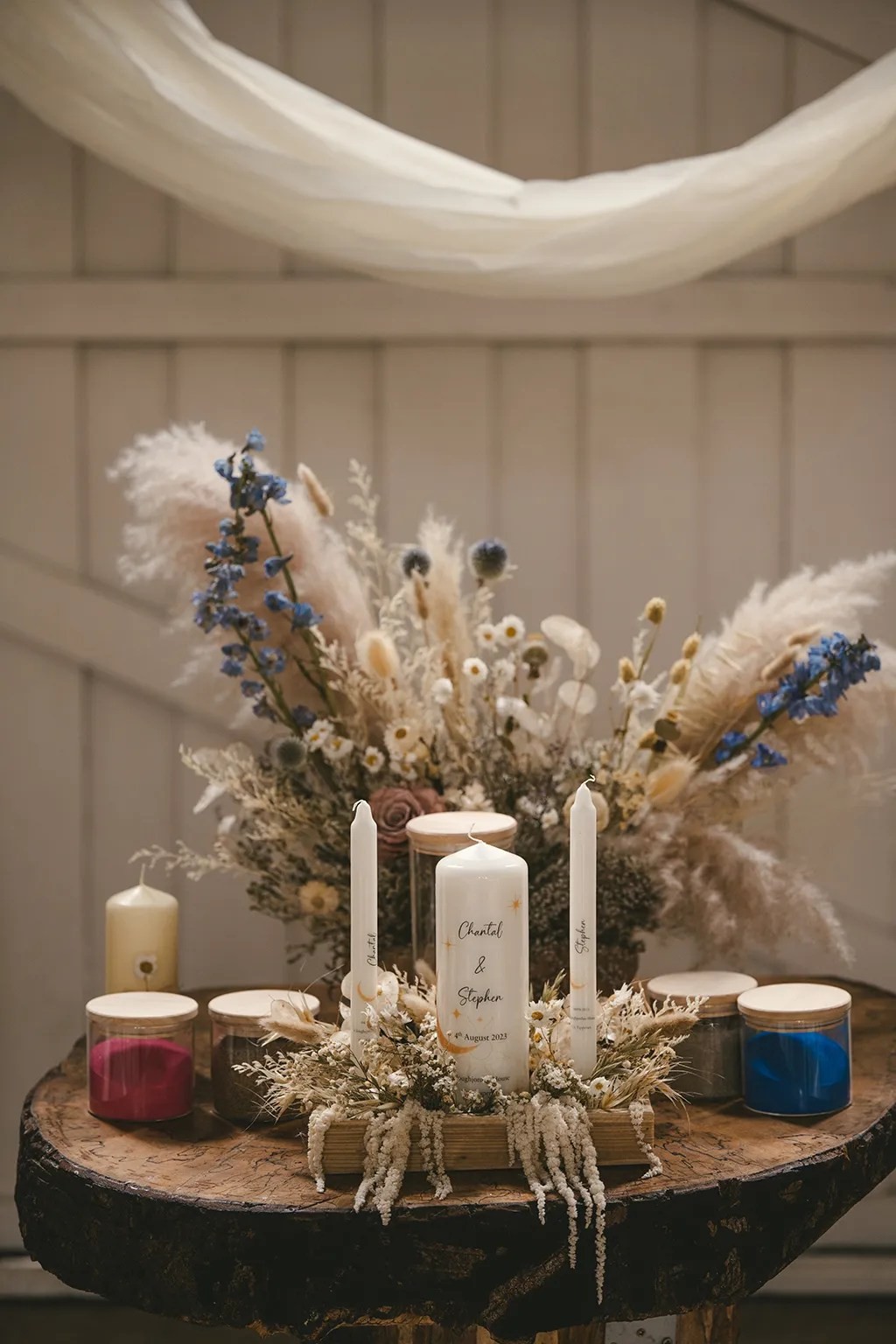 Two individuals pour sand into a glass jar to symbolize their inseparable bond
Two individuals pour sand into a glass jar to symbolize their inseparable bond
Many couples choose to personalize the sand-pouring ritual by using sand from locations that hold special significance to them, such as beaches near where they grew up or places where they shared memorable experiences. Some couples also involve family members, particularly children, by inviting them to add their own containers of sand, symbolizing the blending of two families into one.
The sand-pouring ritual offers a tangible and lasting reminder of the couple’s commitment, as the vessel filled with intertwined sand can be displayed in their home as a symbol of their enduring love.
5. What is the History and Meaning of the Hand-Fasting Ritual?
The hand-fasting ritual is an ancient Celtic tradition that dates back over 2,000 years, symbolizing the binding of two individuals in love and commitment. During this ritual, the couple stands face to face as a celebrant or family member gently binds their hands together with a special cord or ribbon. This act represents their free will decision to join their lives and destinies together.
The hand-fasting ritual is often referred to as “tying the knot,” which has become a common metaphor for marriage itself. The cords or ribbons used in the hand-fasting ceremony can be made from a variety of materials and colors, each representing different aspects of the couple’s relationship, such as love, loyalty, strength, and happiness.
The duration of the hand-fasting can vary, ranging from a few moments to the entire length of the ceremony. Some couples choose to keep their hands bound throughout the ceremony as a constant reminder of their commitment, while others release their hands after exchanging vows or completing other symbolic acts.
6. How Does the Salt-Pouring Ritual Differ From Other Unity Ceremonies?
The salt-pouring ritual is a unique and symbolic ceremony that represents the blending of two individuals and their families. Similar to the sand-pouring ritual, the salt-pouring ceremony involves the couple pouring salt from two individual containers into a single vessel, signifying their union. The shared salt can then be used for cooking at home, symbolizing the couple’s shared life and nourishment.
One of the unique aspects of the salt-pouring ritual is the historical and cultural significance of salt. In many cultures, salt has been a symbol of purity, preservation, and good fortune. By sharing salt, the couple is not only symbolizing their union but also invoking blessings of health, happiness, and prosperity.
Some couples choose to source salt from locations that are meaningful to them, such as salt mines near where they grew up or places where they shared special experiences. This personal touch adds another layer of significance to the ritual.
7. What is the Significance of the Ring-Warming Ritual in Irish Weddings?
The ring-warming ritual is an old Irish wedding tradition that involves passing the wedding rings around the congregation to be “warmed up” by the guests. Each guest holds the rings in their hands for a moment and silently offers a blessing, intention, or wish for the couple. This ritual creates a powerful sense of community and unifies the wedding guests in their support of the couple’s marriage.
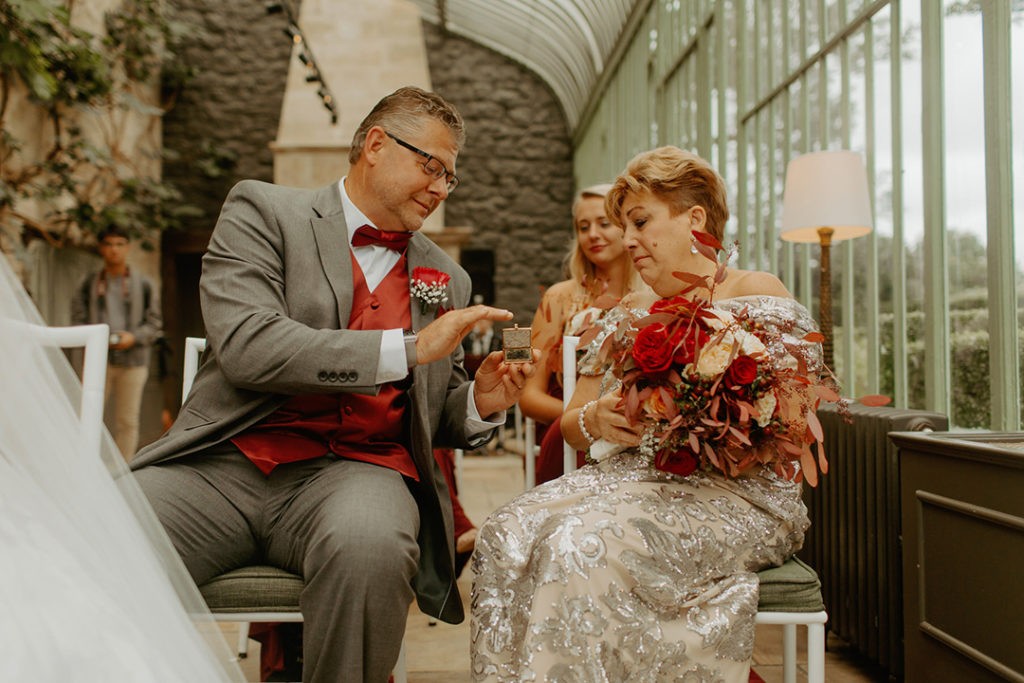 Wedding rings being passed around to wedding guests to be warmed with blessings and well wishes for the couple
Wedding rings being passed around to wedding guests to be warmed with blessings and well wishes for the couple
The ring-warming ritual is a particularly meaningful way to involve guests who may not have other roles in the ceremony. It allows everyone to participate in a tangible and heartfelt way, sending their love and positive energy to the couple.
In some variations of the ritual, the rings are only “warmed up” by certain guests, such as family members or the wedding party. Some couples also take the rings to guests who are unable to attend the wedding, such as elderly grandparents, to be “warmed up” in the days or weeks leading up to the ceremony.
8. What is the Meaning Behind the Rope-Warming Ritual?
The rope-warming ritual is similar to the ring-warming ritual, but instead of rings, a length of rope is passed around to the guests. Each guest takes a moment to hold the rope and offer silent blessings, good wishes, or intentions for the couple’s future.
The rope can then be used in a hand-fasting ceremony, or tied by the couple to symbolize a bond that grows stronger under pressure. The rope-warming ritual is a powerful way to involve the wedding guests in a meaningful way, allowing them to contribute their positive energy and support to the couple’s marriage.
The act of passing the rope from person to person also symbolizes the interconnectedness of the couple’s lives with their community. It represents the support system that will surround them throughout their marriage, providing strength and guidance during challenging times.
9. Why is the Wine Box Ritual a Popular Choice for Wine-Loving Couples?
The wine box ritual is a unique and romantic ceremony that celebrates the couple’s love of wine and their commitment to building a lasting relationship. During this ritual, the couple selects a special bottle of wine to place in a wooden box, along with love letters written to one another. Working together, they then hammer or seal the box closed.
The celebrant explains that the box is to be opened on a significant anniversary, such as their first, fifth, or tenth wedding anniversary. On that special day, the couple will open the box, read their love letters, and share the bottle of wine, reminiscing about their wedding day and celebrating the journey they have taken together.
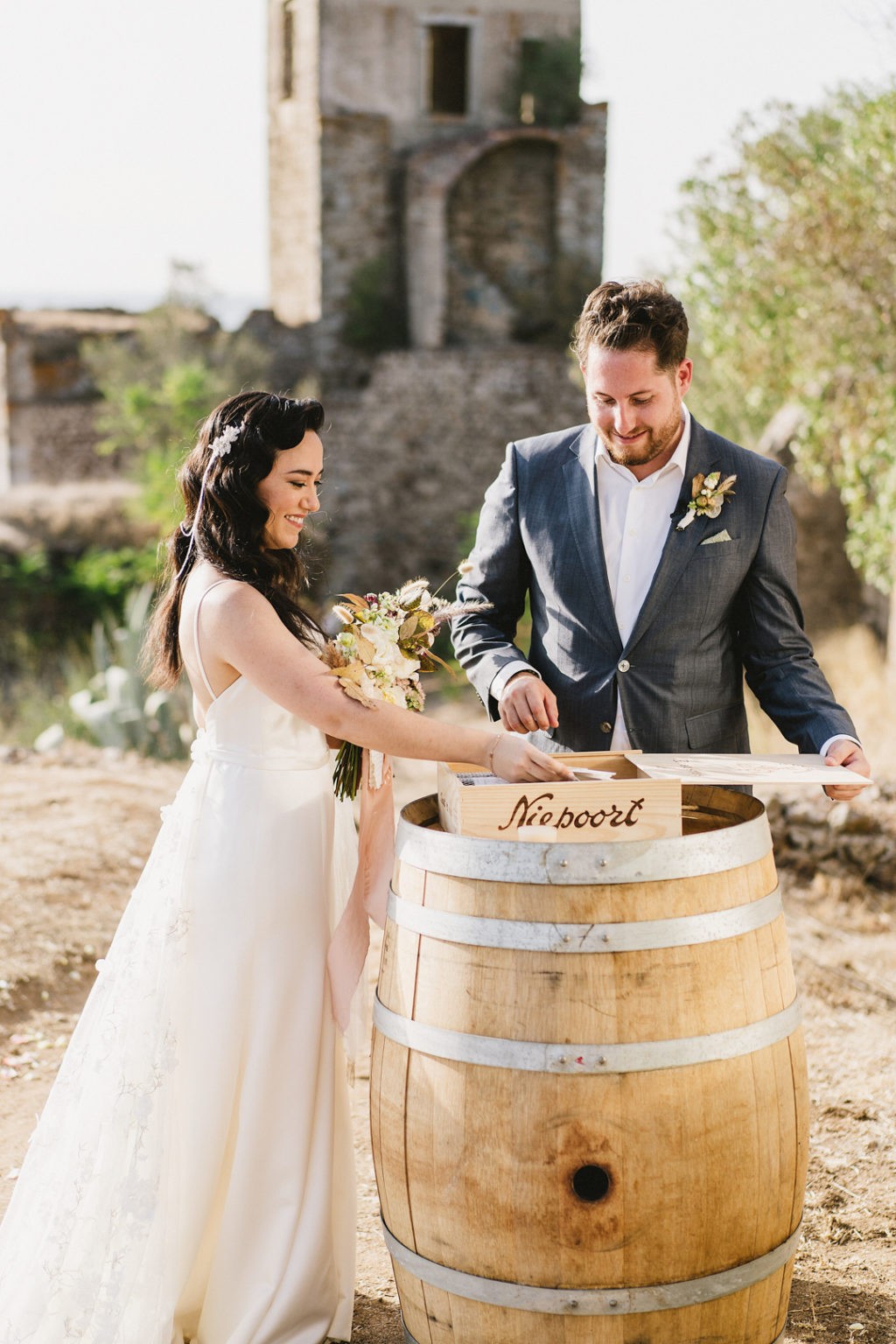 Couple putting a bottle of wine in a wine box along with love letters to be opened on a special anniversary
Couple putting a bottle of wine in a wine box along with love letters to be opened on a special anniversary
The wine box ritual is a beautiful way to create a lasting memory and a tangible reminder of the couple’s love and commitment. It also provides an opportunity for them to reconnect and reaffirm their bond in the years to come.
10. How Does the Love Letter Ritual Create a Lasting Memory?
The love letter ritual is similar to the wine box ritual, but instead of a bottle of wine, the couple seals love letters to one another in a box during the ceremony. The celebrant explains that the box will be opened and the letters read at a later date, often their first or tenth wedding anniversary.
The love letter ritual is a touching way to capture the emotions and promises of the wedding day. The letters serve as a time capsule, preserving the couple’s feelings and intentions at the beginning of their marriage.
When the box is opened, the couple can revisit those emotions and reaffirm their commitment to one another. The love letter ritual is a beautiful way to celebrate the enduring power of love and the importance of communication in a successful marriage.
11. What is the Significance of the Oathing Stone Ritual in Celtic Tradition?
The oathing stone ritual is a Celtic tradition, particularly popular in Scotland, where couples literally set their love in stone by reciting their vows while holding a special oathing stone. In ancient times, an oath given near a stone was considered to be stronger and more binding.
The oathing stone represents the enduring nature of the couple’s commitment, symbolizing their intention to build a solid and lasting foundation for their marriage. Couples often have fun selecting their stone, choosing one from a beach or place that holds special meaning for them.
The oathing stone ritual is a powerful way to connect with Celtic heritage and to imbue the wedding ceremony with a sense of history and tradition.
12. How Do Bread Rituals Symbolize Prosperity in Wedding Ceremonies?
Bread rituals are popular in many cultures, often symbolizing the couple’s prosperity and well-being. During this ritual, parents or guests offer the couple a special loaf of bread, expressing their hope that the couple will never go hungry.
The bread represents nourishment, abundance, and the promise of a fulfilling life together. Combined with the salt and wine rituals, a bread ritual can create a food-themed ceremony that celebrates the couple’s shared love of food and their commitment to providing for one another.
The celebrant may also utter the traditional housewarming blessing: “Bread, that this house may never know hunger. Salt, that life may always have flavor. And wine, that joy and prosperity may reign forever.”
13. Why is the Tree-Planting Ritual a Meaningful Symbol of Growth?
The tree-planting ritual is an ancient tradition with origins in many cultures, symbolizing the couple’s relationship taking root, growing, and flourishing. During this ritual, the couple plants a tree together, representing their commitment to nurturing and supporting one another throughout their lives.
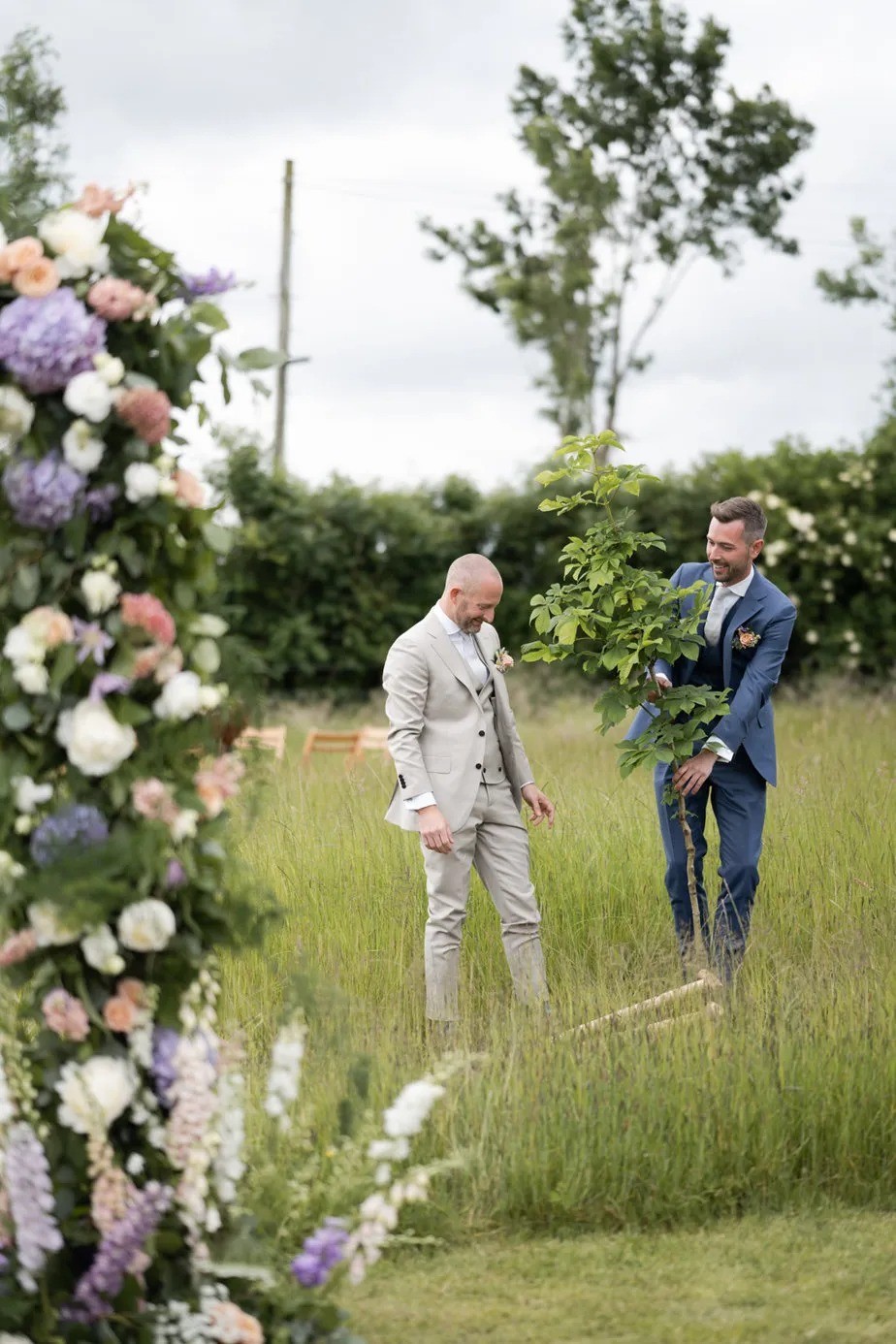 Couple planting a tree together in soil during their wedding ceremony
Couple planting a tree together in soil during their wedding ceremony
The tree-planting ritual is particularly meaningful when getting married at home or near to home, but some wedding venues also accommodate it. The tree serves as a living reminder of the couple’s wedding day and their commitment to growing together.
Couples can personalize the ritual by adding soil from both of their family homes or home countries, symbolizing the blending of their roots. They can also ask family and friends to participate, representing the support system that will help their relationship thrive.
14. How Does the Rose Exchange Ritual Express Love and Commitment?
The rose exchange ritual is a popular ceremony for couples who appreciate old-world romance. During this ritual, the couple offers each other a rose as a token of their love and commitment.
In some variations of the ritual, chosen friends and family members offer the couple single roses, speaking aloud their hopes and dreams for the couple’s future. The rose exchange ritual is a simple yet elegant way to express love, admiration, and unwavering support.
The rose, with its delicate beauty and intoxicating fragrance, is a timeless symbol of love and romance. By exchanging roses, the couple is reaffirming their commitment to cherish and appreciate one another throughout their marriage.
15. What is the Purpose of the Guard of Honour Tradition?
The guard of honour is a tradition that typically takes place after the wedding ceremony, but can also be included at the beginning. It involves a group from the couple’s social circle, such as teammates, coworkers, or military unit members, forming a canopy for the couple to pass through.
The guard of honour symbolizes support, respect, and admiration for the couple. It is a visual representation of the community that surrounds them and their commitment to standing by them throughout their marriage.
The items used to create the canopy can vary widely, reflecting the couple’s interests and hobbies. From sports equipment to work tools, the guard of honour can be a fun and creative way to personalize the wedding celebration.
16. What is the Significance of the Loving Cup Ritual?
The loving cup ritual dates back to Saxon times and involves a ceremonial cup, usually a two-handled silver cup, from which the couple both drink. Sometimes, they also offer it to their guests. The idea is that a drink shared is sweeter, symbolizing unity and togetherness.
The celebrant may recite words to this effect, emphasizing the importance of sharing and companionship in marriage. Some couples drink a blend of two wines, representing the merging of their individual lives. They may also be invited to toast to their past, present, and future.
Using an heirloom cup or glass as the loving cup adds a personal touch, connecting the couple to their family history and traditions.
17. How Does the Sundial Ritual Connect Couples to Ancient Irish Traditions?
The sundial ritual is based on a particular style of ancient Irish sundial and is popular with couples getting married on the Aran Islands. The most common use of the sundial finds couples touching fingers through the dial’s carved hole as they recite their vows. Guests may also pass scarves through the hole three times, offering warm wishes for the couple aloud.
The sundial ritual is a unique and meaningful way to connect with ancient Irish traditions and to honor the history and heritage of the land.
The sundial, with its connection to time and the cycles of nature, symbolizes the enduring nature of love and the passage of time that the couple will share together.
18. How Does the Time Capsule Ritual Preserve Memories of the Wedding Day?
The time capsule ritual is similar to the wine box and love letter rituals, but instead of just wine or letters, the couple seals a collection of special items in a box to be opened at a later date, often a special anniversary. These items might include love letters, a bottle of wine, a newspaper from the day of the wedding, a CD of favorite songs, a wedding invitation, or a ceremony booklet.
The time capsule ritual is a fun and creative way to preserve memories of the wedding day and to create a tangible link to the past.
Some couples invite guests to contribute to the time capsule, including meaningful items or written words of advice. This adds an element of surprise and makes the ritual even more special.
19. Why Do Some Couples Choose to Include a Shot Ritual in Their Wedding?
The shot ritual involves the couple inviting their guests to join them in taking a shot of something alcoholic (or a bottle of beer or a glass of Champagne) during the ceremony to toast their new marriage.
This ritual isn’t for everyone, but if the couple and their celebrant are game, it can be a really cool and unexpected moment. The taking of the shot is accompanied by cheers and well-wishes for the couple, creating a festive and celebratory atmosphere.
The shot ritual is a lighthearted and unconventional way to break the ice and to get the party started.
20. How Does the Puzzle Ritual Symbolize Unity and Collaboration?
The puzzle ritual is a great option for couples who love board games and puzzles. It involves the couple assembling a wooden puzzle during the ceremony to symbolize their unity. This can be a simple logic puzzle or a custom-made puzzle designed specifically for the occasion.
The puzzle pieces represent the individual aspects of the couple’s lives, and the act of putting the puzzle together symbolizes their collaboration and commitment to building a shared life.
The puzzle ritual is also a great way to involve children in the ceremony, as they can help the couple assemble the puzzle.
21. What is the History and Meaning of the Jump the Broom Ritual?
The broom jumping tradition is said to have its origins in both Celtic and West African culture and symbolizes a new beginning, while sweeping away the past. It is also said to signify two families becoming one.
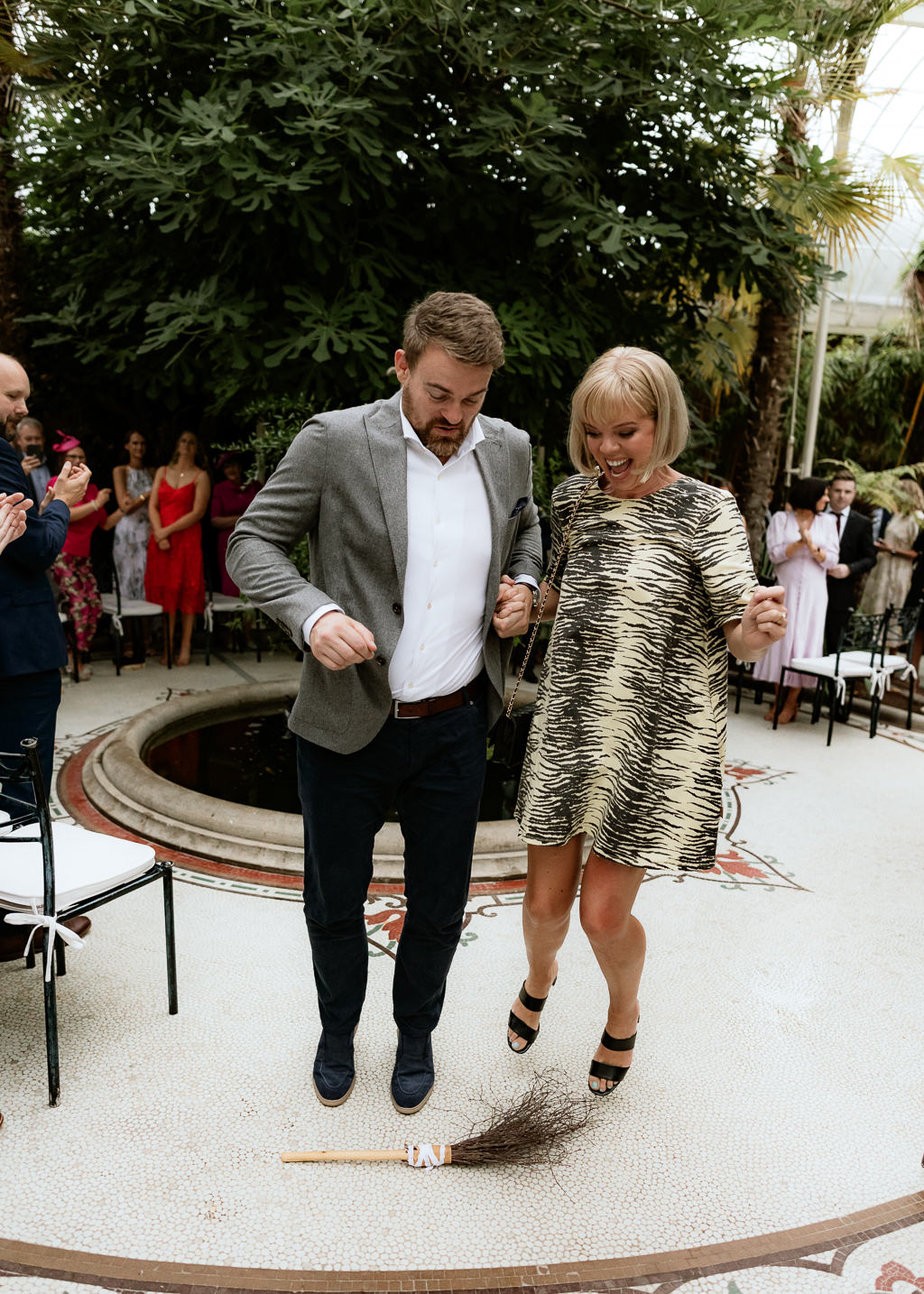 The bride and groom are literally jumping into their new lives together, leaving any old uncertainties behind
The bride and groom are literally jumping into their new lives together, leaving any old uncertainties behind
After completing their wedding vows, the couple quite literally jumps into their new life together, leaving any old uncertainties behind. This ritual is a joyful and symbolic way to start their married life.
The broom itself can be decorated with flowers, ribbons, or other embellishments to reflect the couple’s personal style.
22. How Does the Log-Cutting Ritual Represent Overcoming Obstacles?
The log-cutting ritual is an old German tradition that involves the couple working together to cut a log in half with a two-handled saw. The log is said to represent the obstacles they’ll face in their marriage.
The act of sawing through the log symbolizes their commitment to working together to overcome challenges and to build a strong and resilient relationship.
The log-cutting ritual is a physically demanding and symbolic way to demonstrate the couple’s determination to face life’s challenges head-on.
23. What is the Significance of the Bell Ringing Ritual in Irish Weddings?
The bell-ringing ritual is based on an old Irish custom dating from the Penal Times (1695 to 1829), when church weddings were forbidden in Ireland. People married in barns and cottages, and guests brought along a bell to ring in good luck and prosperity for the newly married couple, as there were no church bells.
The ringing of the bells is a joyful and celebratory way to mark the beginning of the couple’s married life. It is also thought to ward off evil spirits and to bring good fortune to the couple.
Children’s handbells, which are tuned to different notes, make a particularly joyful sound when rung by guests at the end of the ceremony.
24. What is the Purpose of the Tea Ceremony Ritual in Chinese Weddings?
The tea ceremony ritual is a traditional Chinese ceremony, known as cha dao, that formally welcomes a bride or groom to the family. It takes place on the day of the wedding and acts as a mark of respect and gratitude.
The couple kneels in front of their parents and grandparents, as well as extended family members such as aunts, uncles, and cousins, and offers them tea. Traditionally, the bride wears a red dress made from silk or satin with gold accents and gold jewellery. The groom can wear a red tie with his suit. The color red symbolizes happiness, prosperity, and luck.
Elders usually recite well-wishes during the ritual and may give the couple gifts as a sign of their love and support. The tea ceremony ritual is a beautiful and meaningful way to honor family traditions and to express gratitude to elders.
Planning your trip to Vietnam and looking to experience a traditional Vietnamese wedding ceremony? Let SIXT.VN take care of all your travel needs. From airport transfers to hotel bookings and guided tours, we’ve got you covered.
- Personalized Travel Plans: SIXT.VN offers custom itineraries tailored to your preferences, including attending traditional wedding ceremonies.
- Airport Transfers: Start your trip stress-free with our reliable and comfortable airport transfer services.
- Hotel Bookings: Choose from a wide range of accommodations that fit your budget and preferences.
- Guided Tours: Explore Vietnam’s rich culture and heritage with our expert-led tours.
Contact SIXT.VN today to plan your unforgettable adventure in Vietnam!
Address: 260 Cau Giay, Hanoi, Vietnam
Hotline/Whatsapp: +84 986 244 358
Website: SIXT.VN
(Keywords: Vietnam travel, traditional weddings, airport transfer, hotel bookings, guided tours, cultural rituals, SIXT.VN, travel planning, honeymoon planning, cultural immersion)
FAQ: Traditional Wedding Ceremonies
1. What are some common traditional wedding ceremonies?
Common traditional wedding ceremonies include vow exchanges, ring exchanges, candle-lighting rituals, sand-pouring rituals, hand-fasting rituals, and tree-planting rituals. Each ceremony has unique symbolism representing love, unity, and commitment.
2. Why are wedding rituals important?
Wedding rituals are important because they symbolize the couple’s commitment, honor cultural traditions, and involve family and friends in the celebration. These rituals create meaningful memories and strengthen the bond between the couple.
3. How can I personalize my wedding ceremony?
You can personalize your wedding ceremony by writing your own vows, choosing music that is meaningful to you, incorporating cultural traditions, and involving family members in the ceremony. Consider adding personal touches that reflect your unique love story.
4. What is a unity candle ceremony?
A unity candle ceremony involves the couple lighting a single candle from two individual candles, symbolizing the merging of their lives, families, and futures. The unity candle flame represents enduring love and commitment.
5. What is a hand-fasting ceremony?
A hand-fasting ceremony is an ancient Celtic tradition where the couple’s hands are bound together with a cord or ribbon, symbolizing their commitment and free will to join their lives and destinies together.
6. What is the significance of the ring exchange?
The ring exchange is a near-universal element of wedding ceremonies, symbolizing the eternal and unbreakable bond between two people. The circular shape of the ring represents never-ending love and commitment.
7. How can I involve family in my wedding ceremony?
You can involve family by asking them to perform readings, participate in rituals like the unity candle or sand-pouring, offer blessings, or give speeches. Including family members can make the ceremony more meaningful.
8. What is a wine box ceremony?
A wine box ceremony involves the couple placing a special bottle of wine and love letters in a wooden box during the ceremony. The box is opened on a significant anniversary, creating a lasting memory and a tangible reminder of their love and commitment.
9. What are some unique wedding ceremony ideas?
Unique wedding ceremony ideas include a tree-planting ritual, a shot ritual, a puzzle ritual, or a bell-ringing ritual. These unconventional ceremonies can add a personal and memorable touch to your wedding.
10. What is the Jump the Broom Ritual?
The broom jumping tradition is said to have its origins in both Celtic and West African culture and symbolizes a new beginning, while sweeping away the past. It signifies two families becoming one and is a joyful way to start married life.



